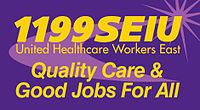Members 347,139 (2013) Founded 1932 | Affiliation SEIU | |
 | ||
Full name 1199SEIU United Healthcare Workers East Head union George Gresham, president, 2007-Present Key people Dennis Rivera, president 1989-2007 Similar Service Employees Internatio, Retail - Wholesale and Depa, AFL–CIO, Healthfirst, Excellus BlueCross BlueShield Profiles | ||
1199SEIU United Healthcare Workers East is the largest healthcare union the United States. With a membership of 400,000 including retirees, its stated mission is to achieve quality healthcare, good jobs and social justice for all. It is the largest local union within the Service Employees International Union.
Contents
History
Local 1199 was founded in 1932 as a local of the Drug, Hospital, and Health Care Employees Union by Leon J. Davis to organize pharmacists in New York City. The local also included pharmacists, pharmacy clerks and "soda jerks". The union led pioneering pickets and strikes against racial segregation and racially discriminatory hiring in Harlem and elsewhere in New York City during the 1930s.
The House Un-American Activities Committee investigated Local 1199's leadership in 1948 for Communist "infiltration". 1199 was a tiny local at the time, however, and during the expulsions of large left-led unions from the CIO in the 1940s, 1199 eventually found shelter under the auspices of the Retail, Wholesale and Department Store Union.
Local 1199 first successfully organized nonprofessional hospital workers in 1958, mobilizing a heavily Black and Puerto Rican workforce in the first flush of the postwar Civil Rights Movement. On 8 May 1959 about 3500 hospital workers began a strike against seven large private hospitals in New York City that lasted forty-six days. This unprecedented action ended when both sides agreed that labor relations in the hospitals would be supervised by a quasi-public agency, the Permanent Administrative Committee. The committee was successfully challenged in 1962. The local began organizing professional and technical workers in 1963, and in the same year won the right to collective bargaining under provisions of the state's labor relations act. In 1965 it was granted the power to represent workers throughout New York State, won a contract in 1968 that for the first time secured a minimum salary for workers of $100 a week, and in 1973 began to organize registered nurses.
The union's first campaign outside of New York City was the formation of District 1199B in Columbia, South Carolina in 1969. The union led a strike there that never led to a contract, but had success in creating new 1199 districts in Upstate New York, Connecticut, Rhode Island, Philadelphia, elsewhere in Pennsylvania, West Virginia, Kentucky, Ohio, and elsewhere.
Serious faction fights broke out within the flagship New York local and among other 1199 locals after the retirement of the union's original leadership. An initial attempt by the national union to merge with SEIU in the early 1980s prompted the local to leave the RWDS to form a short-lived National Union of Hospital and Health Care Employees during the 1980s, but its constituent locals soon thereafter sought mergers with other unions. Most locals eventually merged with SEIU, but 1199C in Philadelphia, under the leadership of Henry Nicholas, merged with AFSCME. Internal disputes persisted until 1989, when Dennis Rivera became its president. Rivera oversaw the local’s 1998 incorporation into SEIU and a tremendous growth in membership as it integrated smaller SEIU chapters and conducted new organizing drives.
Influence
Martin Luther King, Jr. famously described 1199 as "my favorite union," and the "authentic conscience of the labor movement." His widow Coretta Scott King became the honorary chairman of 1199's organizing campaigns as it sought to expand outside of New York City beginning the late 1960s.
1199SEIU today represents 400,000 registered nurses, techs, aides and other healthcare workers in hospitals, nursing homes, homecare programs, clinics and pharmacies throughout New York State, Massachusetts, New Jersey, Florida, Maryland and Washington, D.C.
More recently, Patrick Gaspard, a former executive vice president for politics and legislation at the union, was the political director for Barack Obama's presidential campaign. Gaspard was appointed White House Political Director during Obama’s first term in office. In addition to collective bargaining for its 400,000 members along the East Coast, 1199 utilizes its substantial budget to lobby and make political endorsements across party lines.
Milly Silva, current executive vice president of 1199SEIU, was the Democratic candidate for lieutenant governor of New Jersey in the 2013 election.
In the winter and spring of 2016, 1199SEIU’s president George Gresham was appointed chair of the Mario Cuomo Campaign for Economic Justice, which was the leading force behind the successful passage of the $15 minimum wage in New York State.
